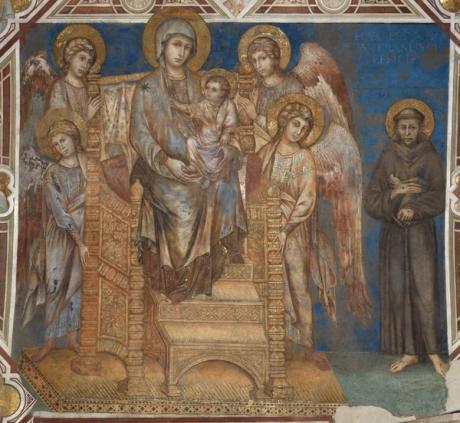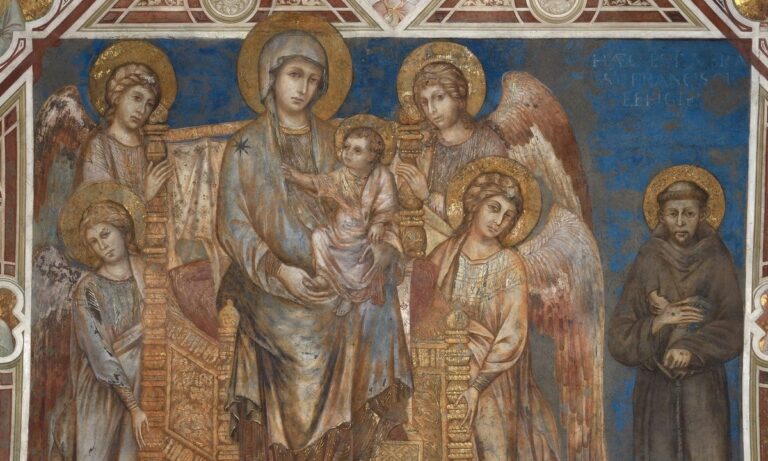
A faded fresco by 13th-century artist Cimabue that survived a deadly earthquake 25 years ago has returned to its original glory after a €300,000 restoration funded by luxury car maker Ferrari. Located in the right transept of the Lower Church of the Basilica of St. Francis of Assisi, a lavishly decorated pilgrimage site in the shadowy city of Assisi, the newly restored work will be officially opened on February 16 following a year-long restoration.
That of Cimabue Virgin enthroned with the Child, Four Angels and Saint Francis (circa 1285-88)—also known as the Majesty of Assisi—represents the Virgin Mary with the child on a throne surrounded by four winged angels and flanked by Saint Francis of Assisi, which is believed to be one of the first representations of the mystic and friar who founded the Franciscan religious order. Repainted at the end of the 16th century, the fresco was previously restored twice: between 1872 and 1874, and in 1973. It survived an earthquake in 1997 that caused the roof of the adjacent upper church to collapse, killing four people.
The project marks the first time that Ferrari has financed an art restoration, Italian state broadcaster Rai reports. “[Italy] is an exceptional country, famous for its artistic heritage that goes back thousands of years,” Benedetto Vigna, the carmaker’s chief executive, said in a statement in December 2022 when the project was announced. “For Ferrari, which belongs to a world of luxury increasingly close to that of art and culture, it is important to contribute to the preservation of a masterpiece.”
The fresco’s vibrant color has been tarnished by dirt deposited by the basilica’s millions of annual visitors, says Sergio Fusetti, the basilica’s chief restorer. The Journal of Art. In addition, the shape of some details—including the beard and ears of St. Francis and the face of the Virgin and Child—had been modified by restorers in the 19th century. In the 1970s, restorers applied a protective coating called Polaroid B72 that made the surface appear reflective and yellowish under modern lighting.
Before the new restoration, Fusetti and a team from Tecnireco, a cultural heritage restoration company based in Spoleto, used X-ray fluorescence and infrared spectroscopy to identify which parts of the fresco were original and which were added later. The analysis also allowed them to determine which pigments Cimabue had used. Experts then cleaned the fresco by removing dirt and the protective layer applied in the 1970s. To avoid painting over the original fresco, they replaced the loose pigment, especially the azurite pigment used for the background, with neutral colors such as gray. “We removed all the additions made over the centuries,” says Fusetti, adding that the painting has now regained its original luminosity. “What we see now is the original work.”
Since the 1997 earthquake, Tecnireco staff have been entrusted with cleaning all the frescoes, which cover an area of 10,000 square meters, once a year. Annual dusting will help maintain Majesty of Assisi in good condition, says Fusetti. “We won’t need to restore it for another 60 or 70, maybe even 100 years,” he adds. “As a result, future maintenance will be more affordable.”

